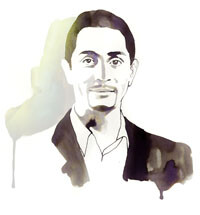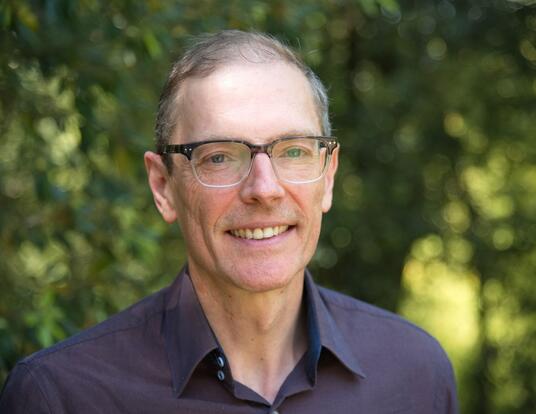Q&A Ray Jayawardhana
An astronomer explores extrasolar planets, while telling stories about the very large and the very small

Ray Jayawardhana uses many of the world’s largest telescopes to explore planetary origins and diversity, as well as the formation of brown dwarfs and stars. His recent research has focused on the detection and characterization of extrasolar planets using high-precision observations in an effort to advance understanding of two types of “extreme worlds”—close-in planets seen in transit and far-out planets that can be directly imaged. He is also an award-winning science writer, a creator of innovative science outreach programs, a popular speaker, and a frequent commentator for the media. Two of his recent books, Strange New Worlds: The Search for Alien Planets and Life Beyond Our Solar System (2011, Princeton University Press) and Neutrino Hunters: The Thrilling Chase for a Ghostly Particle to Unlock the Secrets of the Universe (2013, Scientific American/Farrar, Straus and Giroux), have described scientific quests in the cosmic and the subatomic realms—exoplanets and neutrinos.
Born and raised in Sri Lanka, Jayawardhana holds a BS from Yale University and a PhD from Harvard University. He is now the Dean of Science and a professor of physics and astronomy at York University in Canada.
Q+A ID
Name: Ray Jayawardhana, PhD '00
Field of Study: Astronomy
Today: Dean of Science, York University, Toronto
Why do you think it is important to investigate the universe?
You might think of the universe as being “out there,” remote and untouchable, disconnected from the realities and concerns of our lives here on Earth. But that’s simply not the case. We are connected to the universe at large in myriad and intimate ways. For one, the calcium in our bones, the iron in our blood, and the oxygen we breathe all come from ancient stars that lived and died before our own Sun was born. For another, meteorites from space have almost certainly affected the course of life on our planet—by triggering mass extinctions and perhaps even delivering organic molecules to the young Earth in the first place—and potential asteroid impacts continue to pose a small but serious risk to our very existence.
Moreover, there are umpteen particles from space bombarding the Earth day and night. Giant solar flares not only produce spectacular aurorae but also disrupt satellites and power grids, so “space weather” affects our technological society. Most importantly, I think, investigating the universe is integral to understanding our planet in context, to developing a broader perspective on life—in essence, to making sense of who we are—and to nurturing our sense of wonder.
As a child, you were drawn to space because it represented adventure. Do you still find adventure in studying the stars?
Absolutely. It is exciting to be part of this great human adventure that we call science. The opportunity to explore the unknown, spurred on by curiosity and working with motivated students and colleagues, is an immense privilege. Besides, as a scientist and a writer, I’ve had the chance to visit places that I could only dream of as a child: from astronomical observatories on the arid mountaintops of Chile to the steamy depths of a South African mine accompanying geochemists to collect groundwater, from the ice fields of Antarctica where we camped out for five frigid weeks gathering meteorites to the steppes of western Mongolia to watch a total solar eclipse. A few years ago, I even got to experience the thrill of weightlessness on a parabola-hopping aircraft high above the Atlantic.
In addition to your research, you spend a good amount of time communicating with the public through your popular science books. Why is outreach so important to you?
I guess I inherited my late father’s love of language. As an undergraduate, I wrote for the college newspaper and a science magazine on campus. My lucky break was to get a summer internship at The Economist. After that, I was able to write for various publications during college and graduate school. It’s not always easy for an active researcher to find time to write for a broad audience, but I find it incredibly rewarding. Some of our research papers tend to focus on specific—some might say narrow—albeit interesting questions. Writing for the public gives me a chance to step back a bit, consider the big picture, and pull a number of threads into a compelling story.
More generally, I believe that engaging with the public is an important aspect of being a scientist—plus it is good fun. Science is a splendid human endeavor, one that enriches us tremendously, not only materially but also culturally. So it is incumbent upon us scientists to share our findings and insights, and even glimpses of the often messy and sometimes frustrating process of research. I try to do that through my writing and speaking, and also by organizing public events and outreach initiatives. One project I’m especially proud of is CoolCosmos. During the International Year of Astronomy in 2009, we deployed 3,000 ads, with five catchy designs to pique people’s curiosity about the universe, inside Toronto’s subway cars, buses, and streetcars. It was an attempt to reach a broad cross-section of the population for whom the science of astronomy just does not enter daily life, and remind them about our cosmic connections.
You’ve spent much of your career studying brown dwarfs and extrasolar planets at the macro level. What drew you to write a book about neutrinos?
Neutrinos are extremely interesting elementary particles with rather quirky characteristics. They are all around us: some originate in the nuclear furnace at the Sun’s core, others are created in the upper atmosphere, and yet others are produced beneath our feet when radioactive elements in the Earth’s interior decay. Neutrinos are the most abundant type of matter particle in the universe, yet we have only recently begun to appreciate their starring role in a great many sagas unfolding across physics, cosmology, and astronomy. Needless to say the science of neutrinos is riveting, but so are the stories of the scientists chasing these elusive particles. It was the combination of the fascinating history, the colorful personalities, and the cutting-edge science that drew me
to write Neutrino Hunters.
What are the most exciting discoveries happening in astronomy right now?
If I had to pick, I would say there are two particularly exciting areas of astronomy: exoplanets and cosmology.
When I started graduate school 20 years ago, we knew of only one planetary system around a normal star—namely, our own solar system. Now we know of thousands of planets circling other stars, and the pace of discovery is breathtaking. That’s a dramatic change. But the real story here isn’t just about the numbers—it is the diversity of worlds and of planetary systems that has surprised us and challenged our preconceptions many times over. (My previous book, Strange New Worlds, recounts the saga of exoplanet discovery.)
Cosmology, the study of the origin and evolution of the universe, is ripe with both tantalizing findings but also mind-boggling mysteries. For example, scientists have measured the tiny ripples in the afterglow of the Big Bang (the cosmic microwave background) with exquisite precision. Meanwhile, they are puzzling over the nature of so-called “dark matter” and “dark energy,” which appear to dominate the mass-energy budget of the universe.
How do you think the new generation of telescopes, like the James Webb Space Telescope (JWST), will change what we think we know about the universe?
Every leap in our observing capabilities has resulted in new revelations, many of them quite unexpected. I’m sure that would also be the case with the JWST and the next generation of ground-based telescopes. In my own research area, we are looking forward to using the JWST to characterize some of the nearest exoplanets, to
do “remote sensing” of their atmospheres across tens or even hundreds of light-years.
You were a fellow at the Radcliffe Institute for Advanced Study during the 2011–2012 academic year. What was it like to return to Harvard?
It was fun to be back in Cambridge, reminiscing about old times and making new memories—jogging by the Charles remains a favorite. It was a special delight to be at Radcliffe, interacting with fellows from so many disparate disciplines yet sharing a common sense of curiosity and intellectual engagement.
Illustration by Tina Berning
Get the Latest Updates
Join Our Newsletter
Subscribe to Colloquy Podcast
Simplecast





